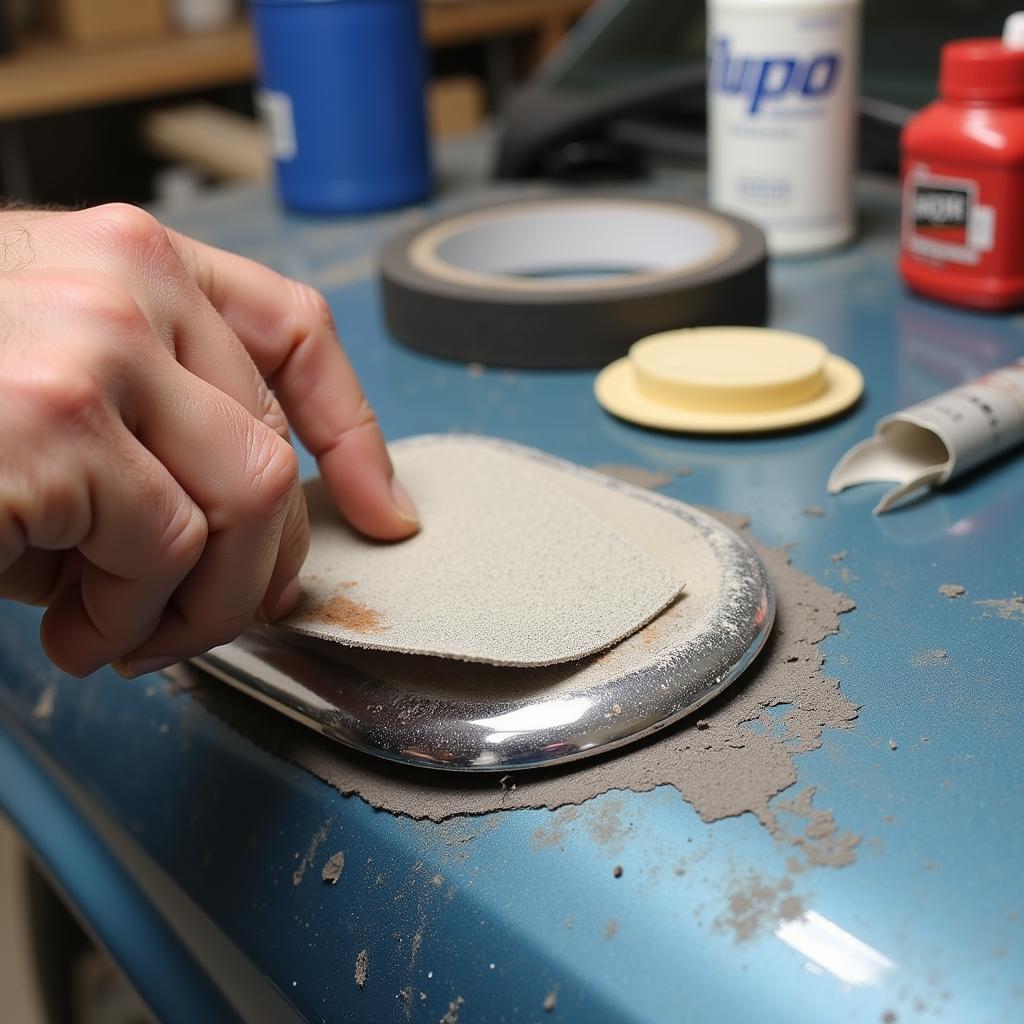Fixing Paint Peeling Car is a common issue that can be caused by a variety of factors, from sun damage and harsh weather conditions to improper car wash techniques and even low-quality paint jobs. This guide will walk you through the causes, solutions, and preventative measures for dealing with peeling car paint.
Why is My Car Paint Peeling?
Several factors contribute to peeling car paint. Understanding these culprits is the first step towards effectively fixing the problem.
Environmental Factors
- Sun Damage: Prolonged exposure to UV rays can break down the chemical bonds in your car’s paint, leading to fading and peeling. Think of it like sunburn for your car.
- Moisture: Water can seep under the paint layer, causing it to lose adhesion and eventually peel. This is especially common in areas with high humidity or frequent rainfall.
- Salt: Road salt used during winter can corrode the metal underneath the paint, accelerating the peeling process.
Mechanical Damage
- Stone Chips and Scratches: These seemingly minor imperfections can expose the underlying metal to the elements, making it vulnerable to corrosion and paint peeling.
- Improper Washing Techniques: Using abrasive cleaning tools or harsh chemicals can strip away the protective clear coat and damage the paint underneath.
Poor Paint Job
- Low-Quality Paint: Using cheap or improperly mixed paint can lead to poor adhesion and premature peeling.
- Incorrect Application: If the surface wasn’t properly prepared or the paint wasn’t applied correctly, peeling is more likely to occur.
Fixing Peeling Paint: A Step-by-Step Guide
Fixing peeling paint involves several steps, from preparation to finishing. Here’s a detailed guide to help you through the process:
- Clean the Affected Area: Thoroughly wash the area with car wash soap and water, removing any dirt, grime, and loose paint flakes.
- Sand the Peeling Paint: Use sandpaper (start with a coarser grit and move to a finer one) to smooth the edges of the peeling paint and feather the surrounding area.
- Apply Primer: Apply a thin, even coat of automotive primer to the sanded area. This will help the new paint adhere properly.
- Apply Paint: Once the primer is dry, apply several thin coats of automotive paint that matches your car’s color, allowing each coat to dry before applying the next.
- Apply Clear Coat: For added protection and shine, apply a clear coat after the paint has dried.
- Wet Sand and Polish: After the clear coat has cured, wet sand and polish the area to blend it seamlessly with the surrounding paint.
Preventing Paint Peeling
Preventing paint peeling is easier and less costly than fixing it. Here are some proactive measures:
- Regular Washing and Waxing: Regularly washing your car removes contaminants that can damage the paint. Waxing provides a protective layer against UV rays and other environmental factors.
- Park in the Shade: Whenever possible, park your car in the shade or use a car cover to protect it from direct sunlight.
- Touch Up Chips and Scratches Promptly: Addressing minor damage immediately prevents them from becoming bigger problems.
Fixing Paint Peeling Car: Expert Advice
“Addressing peeling paint quickly is crucial,” says John Miller, an automotive paint specialist with over 20 years of experience. “Ignoring it will only lead to more extensive and costly repairs down the road.”
Another expert, Sarah Johnson, an automotive restoration specialist, adds, “Using high-quality paint and proper application techniques are essential for a long-lasting paint job. Don’t skimp on these important aspects.”
Conclusion
Fixing paint peeling car is a manageable task with the right approach. By understanding the causes, following the proper repair steps, and taking preventative measures, you can keep your car looking its best. Remember, addressing the issue early can save you time and money in the long run. For any further assistance or professional help, feel free to connect with AutoTipPro at +1 (641) 206-8880 or visit our office at 500 N St Mary’s St, San Antonio, TX 78205, United States.
FAQ
- What type of sandpaper should I use for fixing peeling paint? Start with a coarser grit (e.g., 180-grit) and gradually move to a finer grit (e.g., 2000-grit) for a smooth finish.
- Can I fix peeling paint myself, or should I hire a professional? Minor peeling can often be fixed DIY, but more extensive damage may require professional expertise.
- How much does it cost to fix peeling car paint? The cost varies depending on the extent of the damage and whether you DIY or hire a professional.
- What is the best way to prevent car paint from peeling? Regular washing, waxing, and parking in the shade are key preventative measures.
- How long does it take to fix peeling car paint? The process can take a few hours to a few days, depending on the extent of the damage and the drying times of the products used.
- What kind of paint should I use to fix peeling car paint? Use automotive paint specifically designed for your car’s make and model.
- Can clear coat prevent paint peeling? A clear coat provides an extra layer of protection against UV rays and other environmental factors, helping to prevent paint peeling.





Leave a Reply